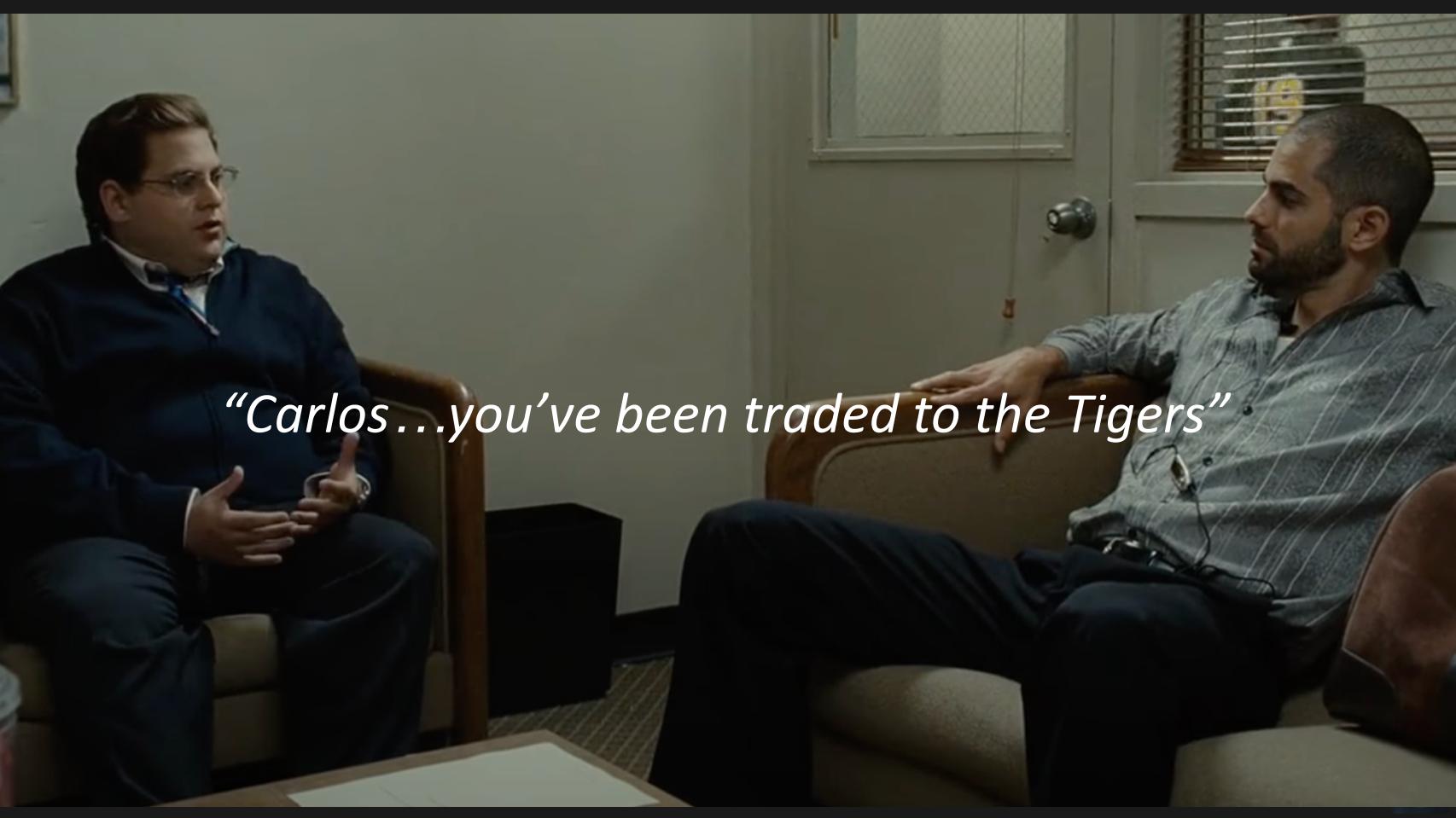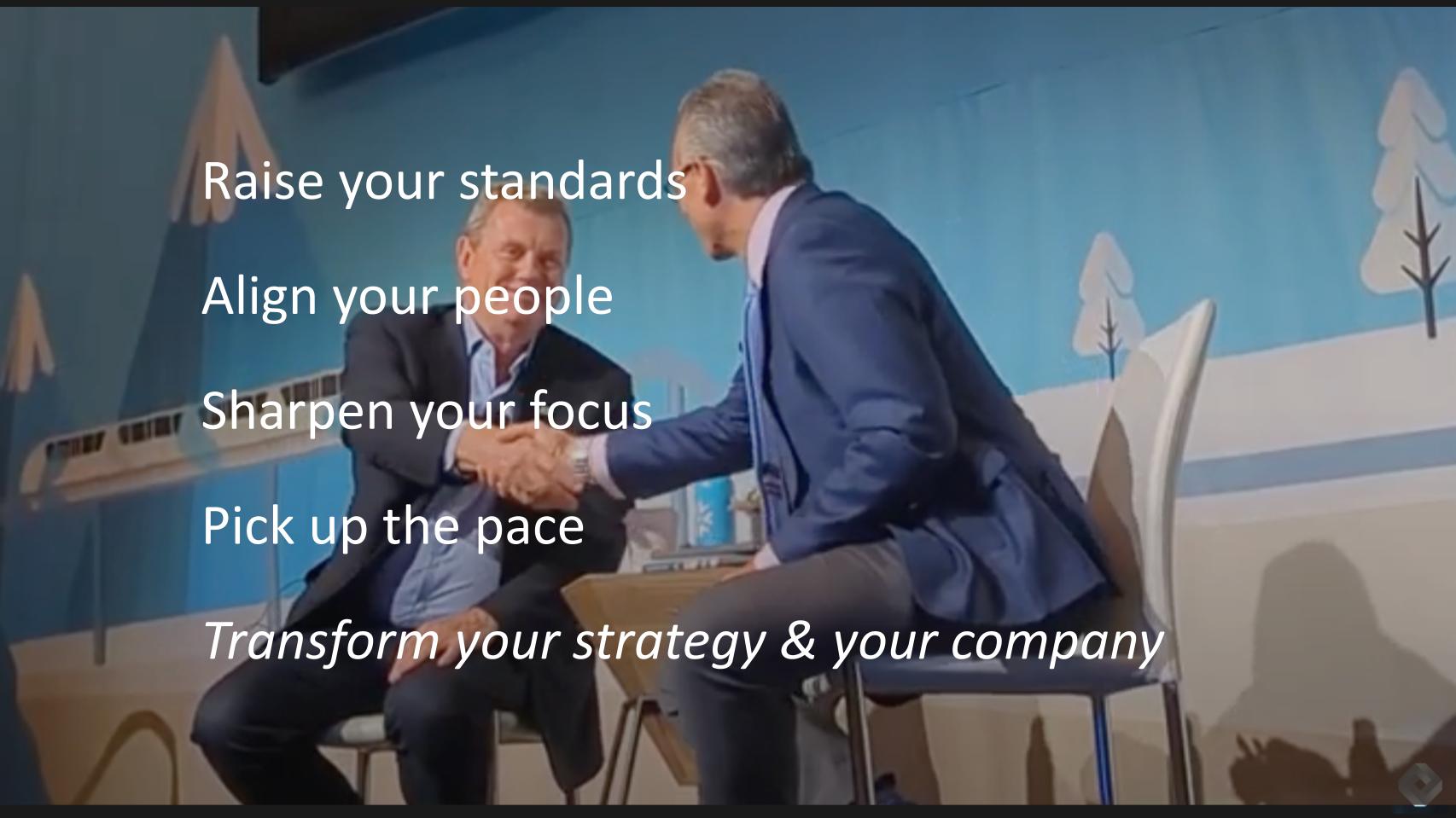Organizations have considerable room to improve their performance without making expensive changes to their talent, structure or fundamental business model. You don’t need a slew of consultants to tell you what to do. You already know. What you need is to immediately ratchet up expectations, energy, urgency and intensity. Fight mediocrity every step of the way. Amp it up and the results will follow.
This is the fundamental premise of a hard hitting new book written by Frank Slootman, CEO of Snowflake, and published earlier this year. It’s called, Amp it Up, Leading for Hypergrowth by Raising Expectations, Increasing Urgency and Elevating Intensity.
At Snowflake Summit last month, I was invited to interview Frank on stage about his book. I’ve read it several times and if you haven’t picked it up, you should. Even if you have read it, in this Breaking Analysis we’ll dig deeper into the book and share some clarifying insights and unpublished nuances of Frank’s philosophy. You’ll hear directly from Slootman himself with excerpts from my one on one conversation with him.
How Does a Busy & Active CEO Find Time to Write a Business Book?
My first question to Slootman was why did you write this book and how the heck did you find time to do it.
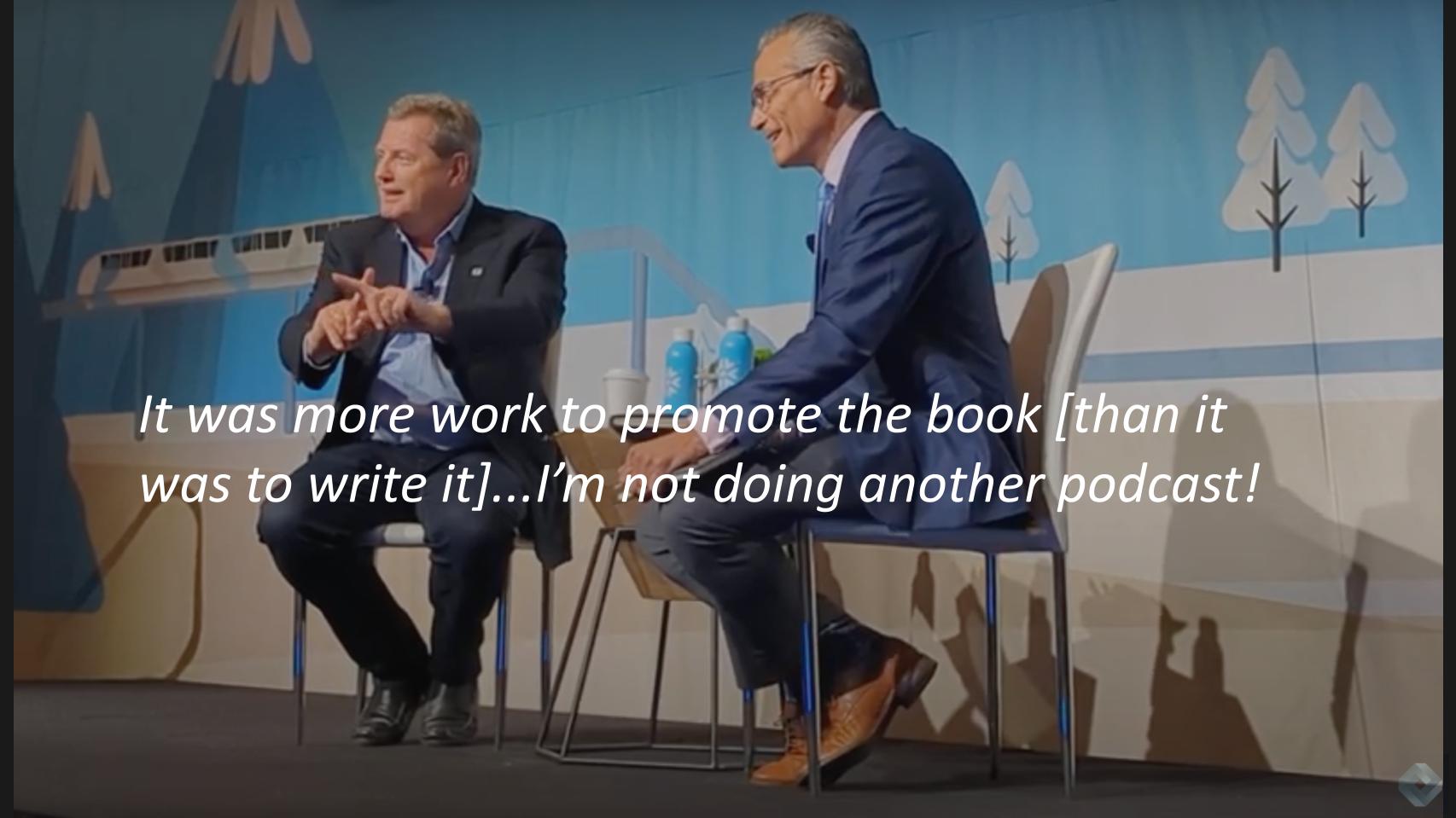
It’s fairly well known that a few years ago, Slootman put up a post on LinkedIn with the title “Amp It Up.” It generated so much buzz and requests for Frank’s time that he decided the best way to efficiently scale and share his thoughts on how to create high performing organizations was to publish a book.
He wrote the book during the pandemic on weekends with help from his CMO, Denise Persson. I joked that they must not have Netflix in Montana where he resides. In a pretty funny moment he said that writing the book was easier than promoting it.
It was a really good process that we funneled through Denise our CMO. She just made sure that it worked for me. It was more work for me to promote this book with all these damn podcasts than actually writing the book. You know, I’m not doing another podcast!
[Listen to Frank Slootman describe the process for writing his new book].
The book gives a lot of interesting background information on Slootman’s career and what he learned at various companies. I won’t go into most of that today, which is why you should read the book yourself. Slootman has become somewhat of a business hero for many people, myself included. Leaders like Slootman, Scott McNealy, Jayshree Ullal and my old boss Pat McGovern, have inspired me over the years and each has applied his or her own approach to building cultures and companies.
Slootman on Pattern Matching, Playbooks & Rinse & Repeat Cultures
When Slootman first took over the reins at Snowflake I published a Breaking Analysis talking about Snowflake and what we could expect from the company now that Slootman and CFO Mike Scarpelli were back together.
In that post, buried toward the end, I referenced the “playbook” that Frank used at Data Domain and ServiceNow – two companies that I followed quite closely as an analyst. And how it would be applied at Snowflake.
[Listen to my quip about the Slootman playbook back in 2019].
Frank reached out to me and said something to the effect of:
I don’t use playbooks, I am a situational leader. Playbooks work in football games, but in the military they teach you situational leadership.
That was an interesting learning moment for me so I asked Frank on stage about this. Here’s what he said:
You know, it is true, the older you get, the more experience that you have, the more you become a prisoner of your own background. Because you think in terms of what you know, as opposed to getting outside of what, you know and try to look at things like a five year old that has never seen this before. And then think about how would you deal with it. And I really try to force myself into thinking, ‘I’ve never seen this before and how do I think about it?’ Because at the least, they’re very different interpretations. And I try to be open minded to avoid that rinse and repeat mentality.
You know, I’ve brought people in that I’ve worked with before…some of them come with me from company to company and they were falling prey to rinse and repeat. I would just literally go like, ‘it is not what we want.’
[Listen to how Frank Slootman thinks about new opportunities and shuns rinse and repeat thinking].
So think about that for a moment. Imagine coming in to lead a new company and forcing yourself and your people to forget what they know that works in the past. Put that aside and assess the current situation with an open mind. Start over.
Now that doesn’t mean you don’t apply what’s worked in the past. Slootman talked to me about bringing back Scarpelli and the synergistic relationship they have and how they build cultures and the no BS / hard truth mentality they bring to companies. But he bristles when people ask him what type of CEO he is – “do we have to put a label on it” he said… “it depends on the situation.”
Should They Stay or Should They Go?
One of the other really hard hitting parts of the book was the way Frank deals with who to keep and who to let go.
He uses the Volkswagen tagline of “Drivers Wanted.” He says in his book – in companies there are passengers and drivers…we want drivers. He said you need to figure that out really quickly and basically get the wrong people off the bus, keep the right people, bring in new people that fit the culture and put them in the right position at the company.
These are not easy decisions to make. But as it pertains to getting rid of people I’m reminded of the movie Moneyball. Art Howe, the manager of the Oakland A’s refused to play Scott Hatteberg, a former catcher, at first base. So the GM, Billy Bean, played by Brad Pitt, says to Peter Brand, who is played by Jonah Hill, you have to ‘fire’ Carlos Pena. Billy Bean says just keep it quick, tell him he’s been traded and that’s it.
So I asked Frank, okay I get it…like the movie, when you have the wrong person on the bus you just have to make the decision, be straightforward and do it. But what if you’re on the fence. What if you’re not completely sure if this person is a driver or a passenger. If he or she should be on the bus or not. How do you handle that? Here’s what he said:
I have a very simple way to break ties and when there’s doubt, there’s no doubt. Okay?
Slootman’s philosophy is you have to be emphatic and have high conviction. To the baseball analogy, if you’re thinking about taking the pitcher out of the game…take him out. Confrontation is the single hardest thing in business according to Slootman. But you have to be intellectually honest. It’s uncomfortable and in business and life it’s natural to want to avoid confrontation. It’s painful. But he says that unfortunately as a leader people are not only watching what you’re doing but they’re also watching what you’re not doing and you have to do what’s best for the organization. Period.
Ok, so wow that may sound harsh but that’s how Slootman approaches it. Very Belicheckian. And it works. But he understands it’s not for everybody.
Amping it Up Everyday
How can you bring this amp it up mentality to the organization on a daily basis? What’s the approach that Slootman takes?
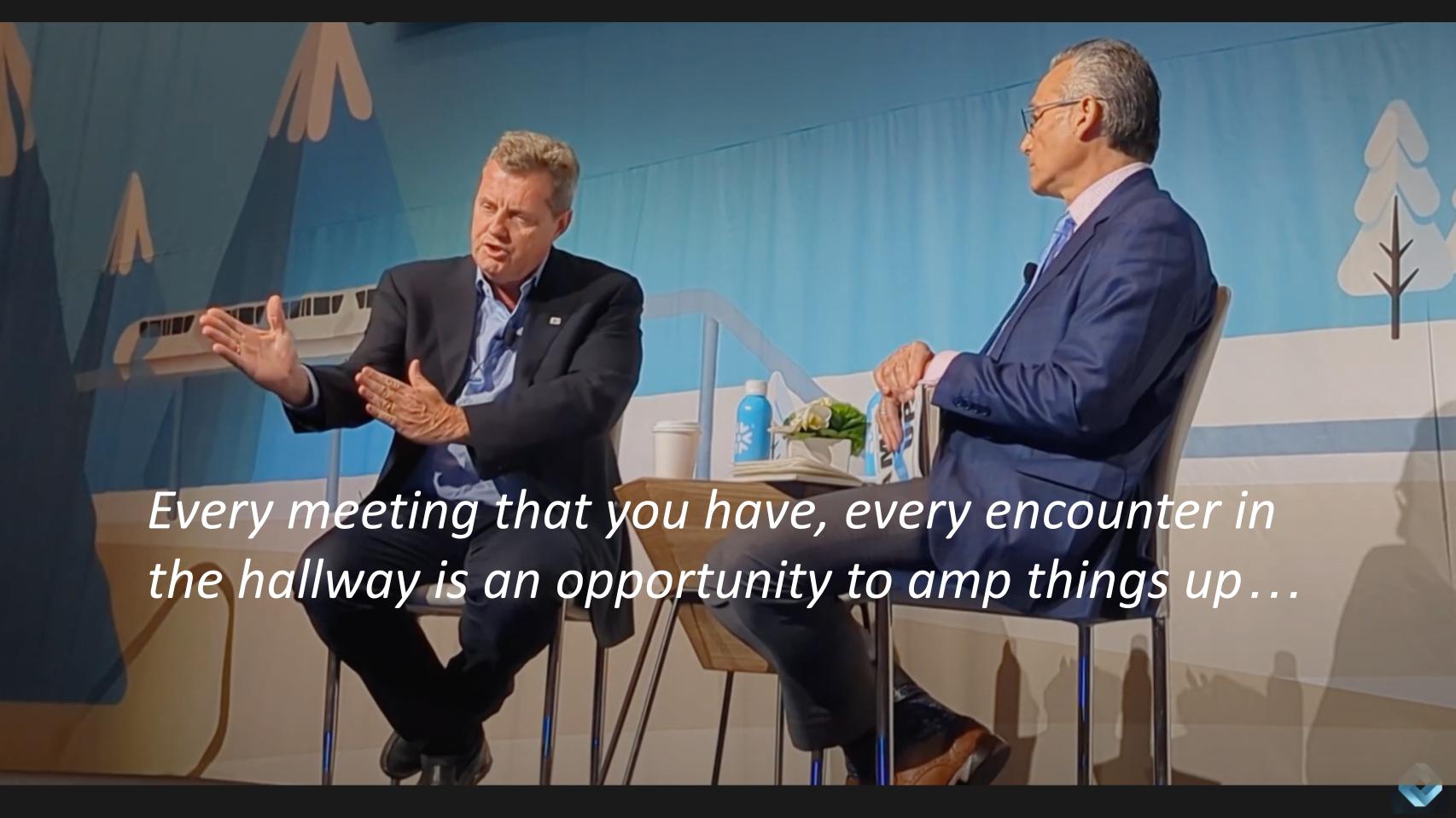
We got into this conversation with a discussion about MBOs, management by objective. Slootman in his book says he’s killed MBOs at every company he’s led and I asked him to explain why. And his rationale was that individual MBOs invariably end up in a discussion about relief of the MBO if the person is not hitting targets. And that detracts from the organizational alignment. He said at Snowflake, everyone gets paid the same way from the execs on down. No MBOs focused on the individual.
It’s a key way he creates focus and energy in an organization. By creating alignment, urgency and putting more resources into the most important things. This is especially hard as the organization gets bigger but if you do approach it this way, Slootman says everything gets easier. The cadence changes, the tempo changes and it works.
And to emphasize that point he said the following:
And according to Slootman, if you don’t take that opportunity, if you’re not in the moment, amping it up…then you’re thinking about your golf game or the tennis match this weekend or being out on your boat. And to the point, this approach is not for everyone. You’re either built for it or not. But according to Slootman, if you can bring people into the organization that can handle this type of dynamic, it creates energy. It becomes fun. Everything moves faster. The conversations are exciting. They’re inspiring. And it becomes addictive.
Slootman on Priorities – If you had to Choose to do Just One Thing…
I said to Frank that for me anyway, his book was an uncomfortable read. He was somewhat surprised by that. “Really?” He said. I explained that it was an easy read but uncomfortable because over my career, I’ve managed thousands of people. Not tens of thousands but thousands. Enough to have to take this stuff very seriously. And I found myself throughout the book, on the one hand saying to myself – “oh I got that right.” And then other times thinking to myself – “oh wow, I probably need to amp it up on that front.” And to Frank’s leadership philosophy, there is no one correct way to approach all situations. You have to figure it out for yourself.
But the one thing in the book that I found the hardest was Slootman challenged the reader – if you had to drop everything and focus on one thing…just one thing for the rest of the year, what would that one thing be?
Think about that for a moment.
Were you able to come up with that one thing? What would happen to all the other things on your priority list? Are they all necessary? If so, how would you delegate those? Do you have someone in your organization who could take those off your plate? What would happen if you only focused on one thing?
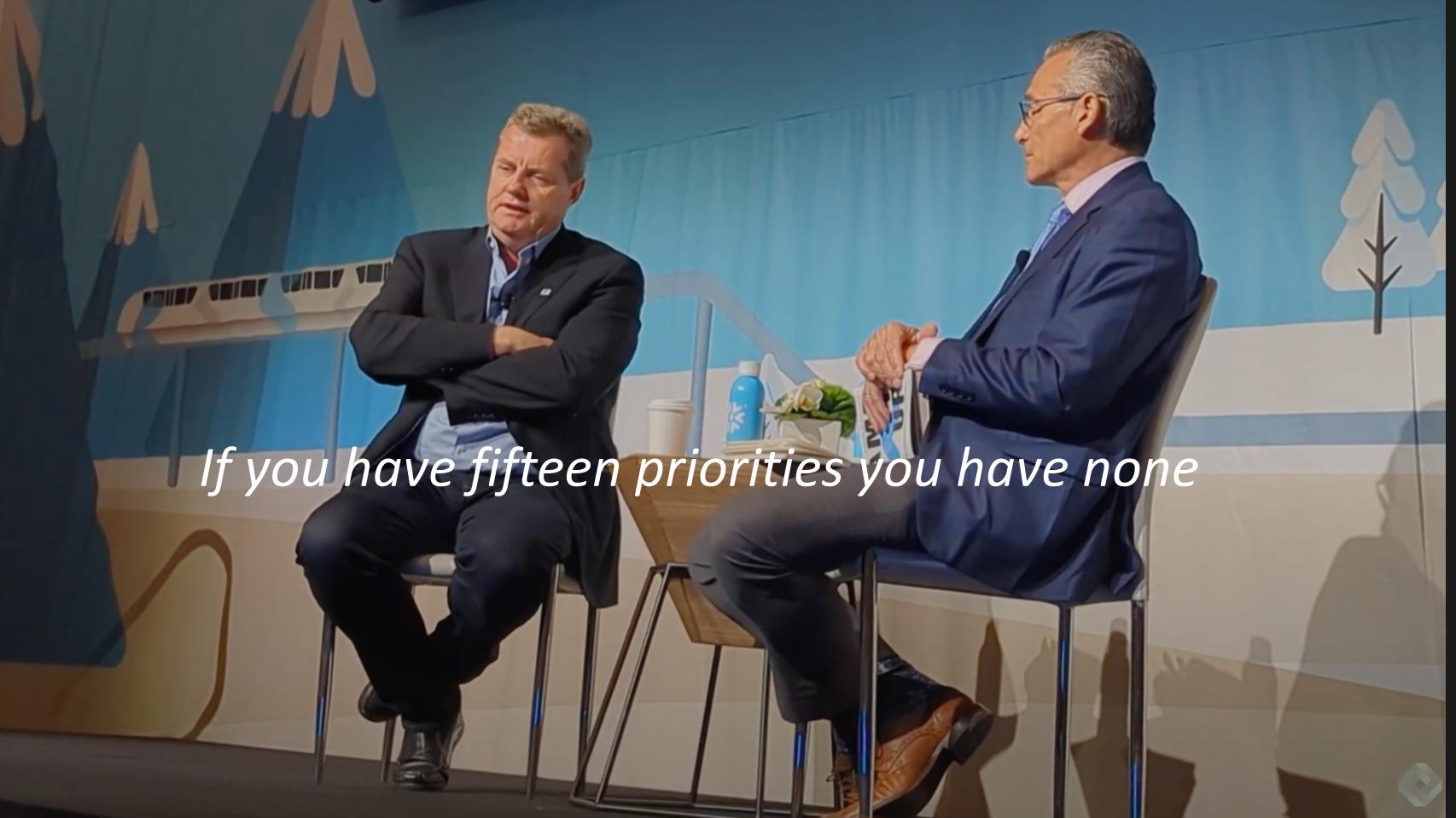
These are hard questions. But Slootman really forces you to think about them. Here’s what he said on stage:
I’ve been on boards and in other meetings. I see the PowerPoint slides from the CEO and there are like 15 things on the list. Here are our priorities for the year. I’m like, ‘you have 15, you’ve got none.’ It’s like you just can’t decide what’s important. So I’ll tell you everything because I just can’t figure it out. And the thing is, it’s very hard to just say one thing. But it’s really the mental exercise that matters.
Look at Frank’s body language in the screenshot above. Imagine going into a management meeting with Frank and being excited and prepared to share all the things you’re working on. And all the priorities you have for the coming year.
Going through that mental exercise is really important according to Slootman. Let’s have a conversation about what really matters at this point in time. Why does it need to happen and does it take priority over other things? Slootman says you have to pull apart the hairball and drive extraordinary clarity. You could be wrong he says. He admits he’s been wrong on many things before. He, like everyone is fearful of being wrong. But if you don’t have the conversation, according to Slootman, you are already defeated.
Ever since reading Frank’s book and going through this mental exercise, every day I think about how I can better focus on that one thing for our business. And for me personally, it’s how to find more time to help the organization create more great editorial content.
What’s your one thing?
Great Execution is More Important Than Strategy
One of the most important things Slootman emphasizes is execution. He said that’s one of the reasons he wrote Amp it Up. In our discussion he referenced Pat Gelsinger, his former boss who bought Data Domain when he was working for Joe Tucci at EMC.
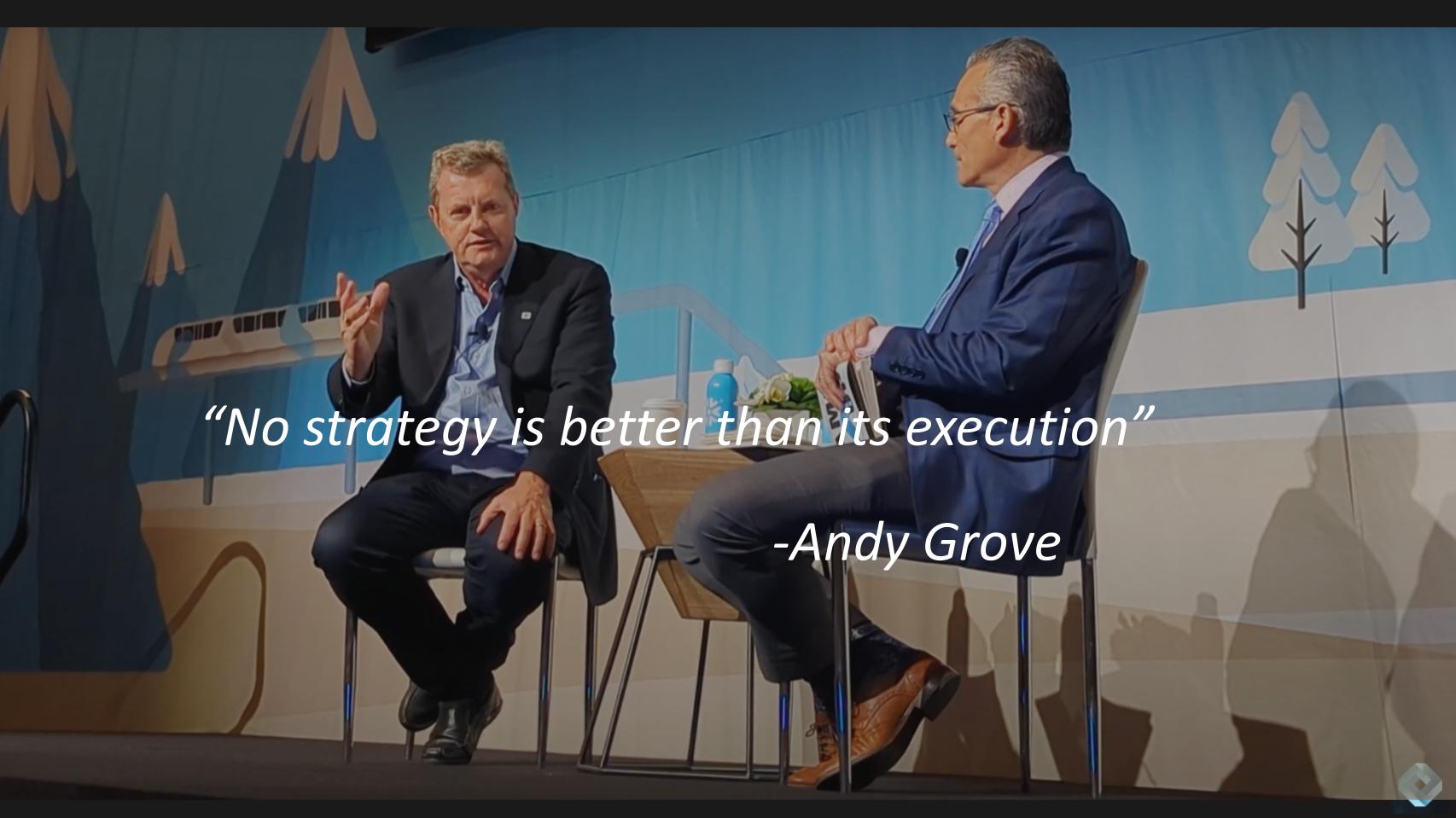
[Listen to Frank Slootman describe the interaction with Pat Gelsinger].
Before you go changing your strategy, says Slootman, you have to eliminate execution as a potential point of failure. All too often he says, Silicon Valley companies wants to change strategy without really understanding whether the execution is right. Companies frequently don’t consider that maybe the product isn’t right. They will make a change to sales leadership without questioning whether there’s product fit.
According to Slootman you have to drive hard core intellectual honesty. And as uncomfortable as that may be it’s incredibly important and powerful.
You Don’t Need a Customer Success Department
Another contrarian points in Slootman’s book was whether or not to have a customer success department. Slootman shared that it became fashionable in Silicon Valley during the SaaS craze to create a department dedicated to customer success. A group that would make what he called ‘diving catches’ when there was a problem. Many companies were following and pattern matching the lead of Salesforce.com.
He says he’s eliminated the customer service department at every company he’s led which had one when he came in.
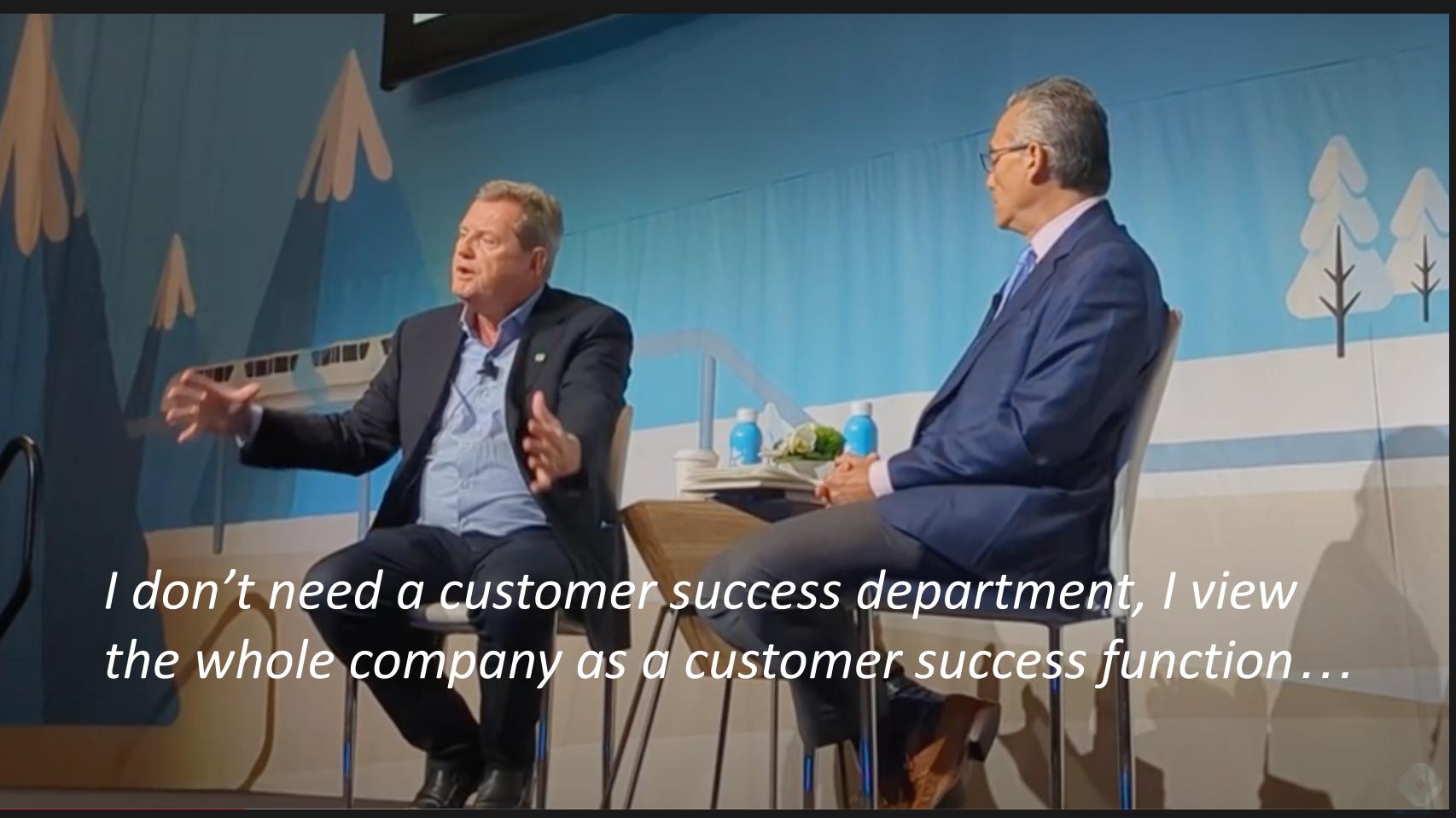
Here’s why according to Slootman:
I view the whole company as a customer success function. I’m customer success. I said it in my presentation yesterday, we’re a customer first organization. I don’t need a department. I need the whole company to be invested.
[Listen to Frank Slootman in his own words talk about the customer success department].
He further explained his thinking on this matter. Sales owns the commercial relationship with the customer, engineering owns the technical relationship. He always puts support in engineering because engineering has to back up support. And rather than having a separate, dedicated department for customer success, he makes sure that the existing departments are functioning properly.
Slootman has always been big on NPS, net promoter score. I remember when he came into EMC some people were off put by the fact that he would stress Data Domain had a much higher NPS than any of the EMC products. He made those EMCers uncomfortable, but Slootman got in their head space and they thought about how to improve. Snowflake’s NPS is also very high at 72. And according to Slootman, it’s not just the product, it’s the people that drive that type of loyalty.
Even Amping Up the Little Things
Slootman stresses amping up the big things and the little things too.
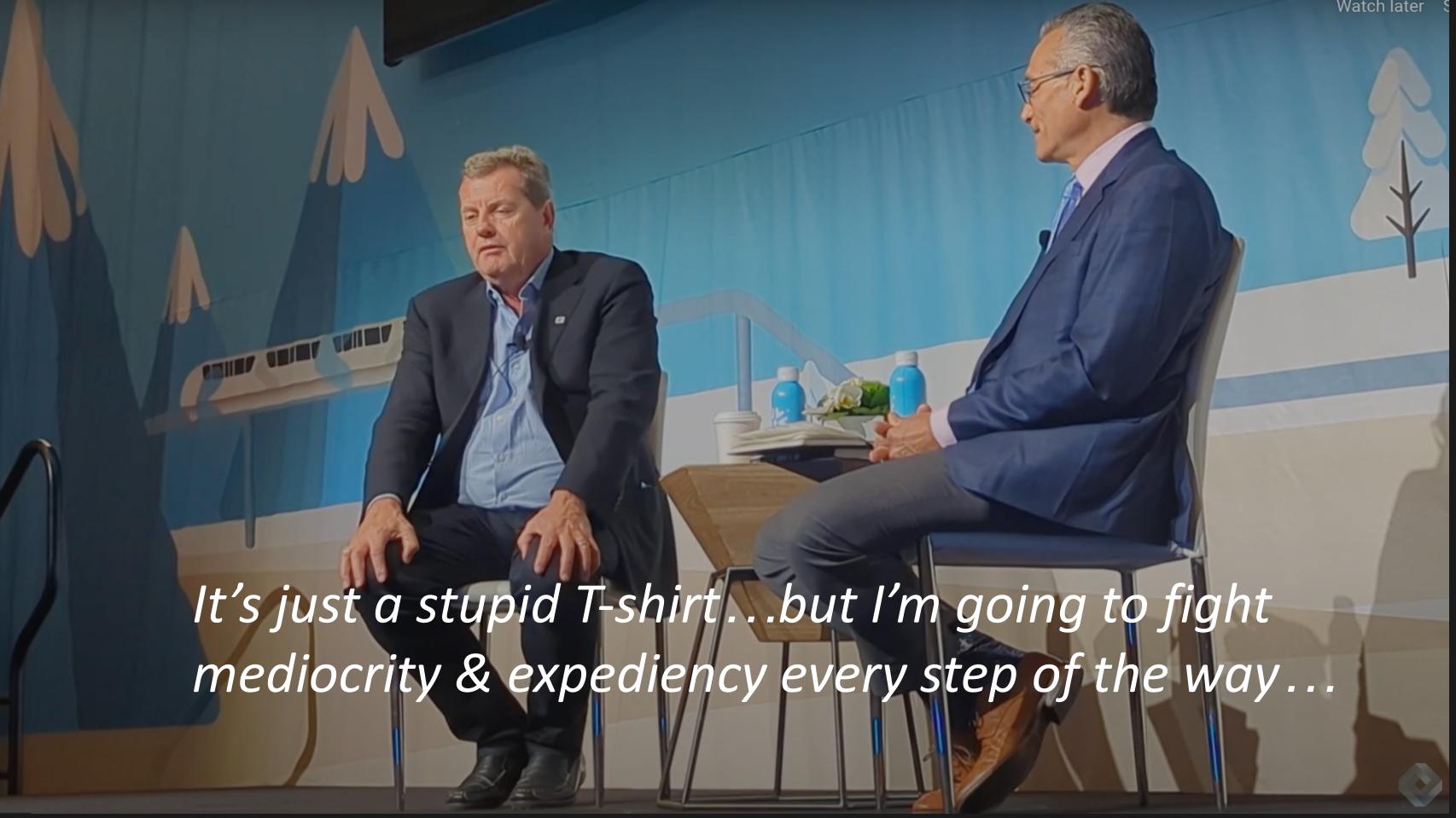
He told a story about someone who came into his office to ask his opinion about a T-shirt they were going to give away. And he turned it around on her and said “what do you think?” And she said – “it’s just okay.” So Frank made his point by flipping the situation. “Why are you coming to me with something that’s just ok,” he asked. His point was if we’re going to do something, let’s do it right and be excited about it. Not just check the box and get something off the desk. Amp it up – all aspects of the business.
He then went on to use the example of Steve Jobs and how he would never accept mediocrity. Jobs was ruthless. Frank pointed out that he’s not as aggressive in that sense. Speaking of Jobs, Slootman said:
He was incredibly intolerant of anything he didn’t think it was great. He was immediately done with it and with the person. I’m not that aggressive in that way. I’m a little bit nicer about it. But I still don’t want to give into expediency and mediocrity. I just don’t. I’m just gonna fight it every step of the way.
Amping Up in Big Ways – Changing Snowflake’s GTM to Focus on Industries
That T-shirt story was about a little thing like some swag. But Slootman talked about some big things too. And one of the major ways Snowflake was making big, sweeping changes to amp up its business, was reorganizing its go to market around industries like financial services, media and healthcare.
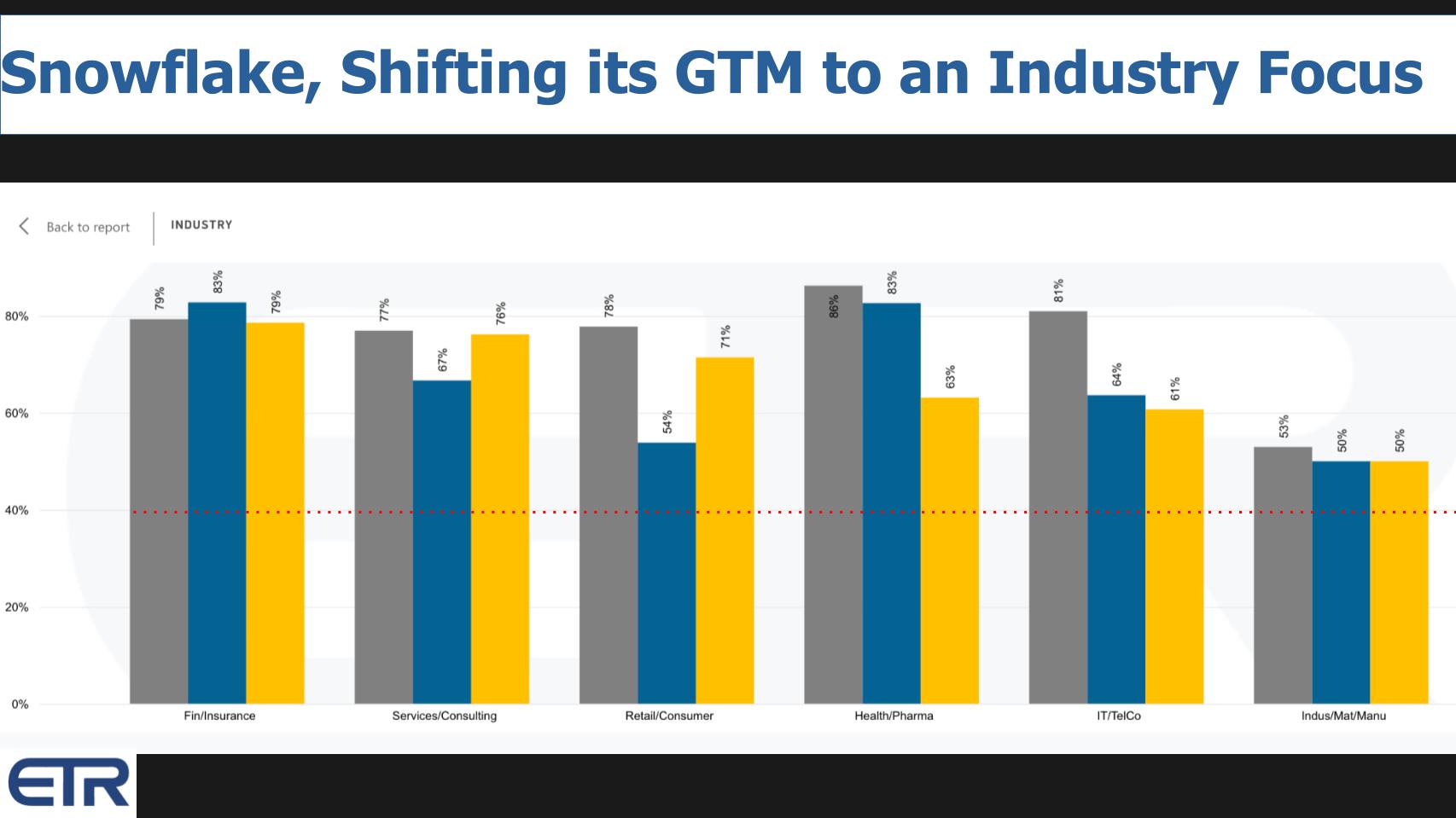
Above is some ETR data that shows Snowflake’s Net Score or spending momentum for key industry segments over time. The red dotted line at 40% is an indicator of highly elevated spending momentum and you can see for the key areas shown, Snowflake is well above that 40% level. We cut this data where response N’s were greater than fifteen. So not huge N’s but large enough to have meaning.
Remember as well that CIO spending expectations, while still strong, are softer than the sentiment pre-inflation, pre-Ukraine, pre-interest rate hikes.
It’s relatively uncommon to see a company that’s having the success of Snowflake make this kind of non-trivial change in the middle of steep S-Curve growth. Why did they make this move? I think it’s because Snowflake realizes that its data cloud is going to increasingly have industry diversity and unique value. That ecosystems and data marketplaces are forming around industries. So the more industry affinity Snowflake can create, the stronger its moat will be.
It also aligns with how the largest and most prominent global SIs go to market. This is important because as companies are transforming, they are radically changing their data architecture and the way they approach data as a competitive advantage. And monetization opportunity. So having industry expertise, knowledge and aligning with customer objectives will serve Snowflake and its ecosystem well. And the SI’s have deep industry expertise that Snowflake can feed to accelerate transformations.
Slootman even said, he joined the board of Instacart, not because he needed another board seat, but he wanted to get out of his comfort zone and expose himself to other industries as a way to learn.
The Cliff Notes on Amp It Up
So look, we’re barely scratching the surface of Slootman’s book. And I’ve pulled some highlights from our conversation. There’s so much more even from that sit down that I can share and will as the opportunity arises.
But for now I’ll just give you the bumper sticker of Amp it Up.
- Raise your standards by taking every opportunity, every interaction to increase your intensity;
- Get your people aligned and moving in the same direction. If it’s the wrong direction – figure it out fast and course correct;
- Prioritize and sharpen your focus on things that will really make a difference;
- If you do these things and increase the urgency in your organization you’ll naturally pick up the pace and accelerate your company;
Execute well and you’ll be able to transform your organization, better identify adjacent opportunities and create a lasting and meaningful experiences for your employees, customers and partners.
I’d like to thank the Snowflake comms team for inviting me to interview Frank Slootman about Amp It Up. Thanks to Frank for writing the book and spending an hour with me to discuss it at Snowflake Summit. It’s one of the best action-oriented, make you think hard business books I’ve ever read and I encourage you to pick up a copy and use it as a reference for your own management approach.
Keep in Touch
Thanks to Alex Myerson who does the production, podcasts and media workflows for Breaking Analysis. Special thanks to Kristen Martin and Cheryl Knight who help us keep our community informed and get the word out. And to Rob Hof, our EiC at SiliconANGLE.
Remember we publish each week on Wikibon and SiliconANGLE. These episodes are all available as podcasts wherever you listen.
Email david.vellante@siliconangle.com | DM @dvellante on Twitter | Comment on our LinkedIn posts.
Also, check out this ETR Tutorial we created, which explains the spending methodology in more detail.
Watch the full video analysis:
Note: ETR is a separate company from Wikibon and SiliconANGLE. If you would like to cite or republish any of the company’s data, or inquire about its services, please contact ETR at legal@etr.ai.
All statements made regarding companies or securities are strictly beliefs, points of view and opinions held by SiliconANGLE media, Enterprise Technology Research, other guests on theCUBE and guest writers. Such statements are not recommendations by these individuals to buy, sell or hold any security. The content presented does not constitute investment advice and should not be used as the basis for any investment decision. You and only you are responsible for your investment decisions.
Disclosure: Many of the companies cited in Breaking Analysis are sponsors of theCUBE and/or clients of Wikibon. None of these firms or other companies have any editorial control over or advanced viewing of what’s published in Breaking Analysis.

